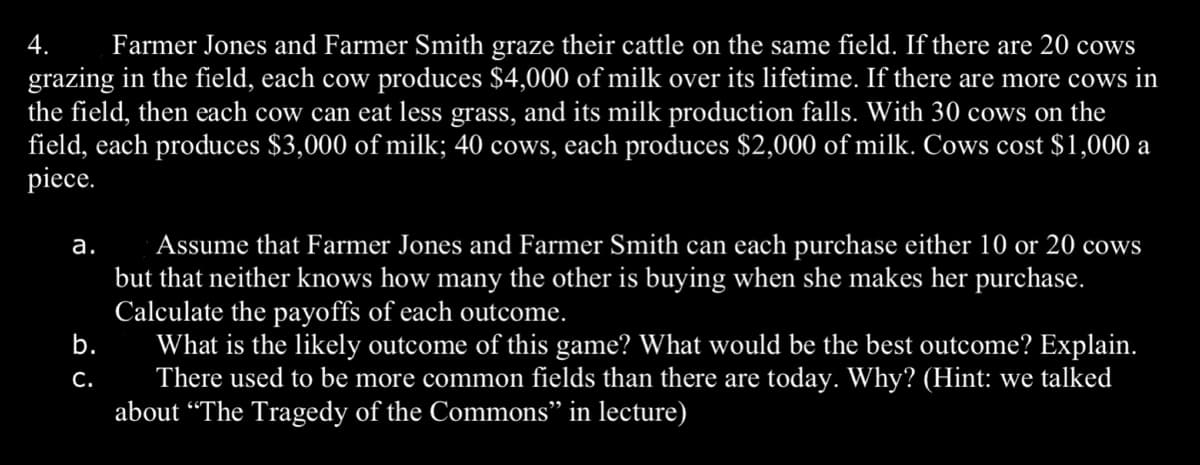4. Farmer Jones and Farmer Smith graze their cattle on the same field. If there are 20 cows grazing in the field, each cow produces $4,000 of milk over its lifetime. If there are more cows in the field, then each cow can eat less grass, and its milk production falls. With 30 cows on the field, each produces $3,000 of milk; 40 cows, each produces $2,000 of milk. Cows cost $1,000 a piece. a. b. C. Assume that Farmer Jones and Farmer Smith can each purchase either 10 or 20 cows but that neither knows how many the other is buying when she makes her purchase. Calculate the payoffs of each outcome. What is the likely outcome of this game? What would be the best outcome? Explain. There used to be more common fields than there are today. Why? (Hint: we talked about "The Tragedy of the Commons" in lecture)
4. Farmer Jones and Farmer Smith graze their cattle on the same field. If there are 20 cows grazing in the field, each cow produces $4,000 of milk over its lifetime. If there are more cows in the field, then each cow can eat less grass, and its milk production falls. With 30 cows on the field, each produces $3,000 of milk; 40 cows, each produces $2,000 of milk. Cows cost $1,000 a piece. a. b. C. Assume that Farmer Jones and Farmer Smith can each purchase either 10 or 20 cows but that neither knows how many the other is buying when she makes her purchase. Calculate the payoffs of each outcome. What is the likely outcome of this game? What would be the best outcome? Explain. There used to be more common fields than there are today. Why? (Hint: we talked about "The Tragedy of the Commons" in lecture)
Principles of Economics 2e
2nd Edition
ISBN:9781947172364
Author:Steven A. Greenlaw; David Shapiro
Publisher:Steven A. Greenlaw; David Shapiro
Chapter13: Positive Externalities And Public Goods
Section: Chapter Questions
Problem 25P: Becky and Sarah are sisters 1who share a room. Their room can easily get messy, and their parents am...
Related questions
Question

Transcribed Image Text:4. Farmer Jones and Farmer Smith graze their cattle on the same field. If there are 20 cows
grazing in the field, each cow produces $4,000 of milk over its lifetime. If there are more cows in
the field, then each cow can eat less grass, and its milk production falls. With 30 cows on the
field, each produces $3,000 of milk; 40 cows, each produces $2,000 of milk. Cows cost $1,000 a
piece.
a.
b.
C.
Assume that Farmer Jones and Farmer Smith can each purchase either 10 or 20 cows
but that neither knows how many the other is buying when she makes her purchase.
Calculate the payoffs of each outcome.
What is the likely outcome of this game? What would be the best outcome? Explain.
There used to be more common fields than there are today. Why? (Hint: we talked
about "The Tragedy of the Commons" in lecture)
Expert Solution
This question has been solved!
Explore an expertly crafted, step-by-step solution for a thorough understanding of key concepts.
This is a popular solution!
Trending now
This is a popular solution!
Step by step
Solved in 2 steps with 1 images

Knowledge Booster
Learn more about
Need a deep-dive on the concept behind this application? Look no further. Learn more about this topic, economics and related others by exploring similar questions and additional content below.Recommended textbooks for you

Principles of Economics 2e
Economics
ISBN:
9781947172364
Author:
Steven A. Greenlaw; David Shapiro
Publisher:
OpenStax


Principles of Economics 2e
Economics
ISBN:
9781947172364
Author:
Steven A. Greenlaw; David Shapiro
Publisher:
OpenStax
